Performance Assessment of Concrete Using Discarded Membrane Filter Materials
Abstract
:1. Introduction
2. Material Preparation for Membrane Recycled Concrete
2.1. Material Preparation
2.2. Mortar Test of ABS/PVDF Mixture
3. Experimental Study
3.1. Preparation of OPC, ABS, and PVDF Concrete
3.2. Experimental Results
3.3. Experimental Discussion
4. Conclusions
- It was found that carbon emission reduction of approximately 50 kg CO2/m3 is possible through waste membrane recycling and cement replacement. This is equivalent to 10 pine trees absorbing 5.6 kg of CO2 per year.
- To use the discarded membrane module as substitutes of cement, the outer casing (ABS) of membrane module and inner membrane (PVDF) should be made into powder form with a frozen pulverizing process.
- The concrete specimens were made with ABS and PVDF with 1 wt%, 3 wt%, 5 wt% to substitute cement, and the air contents test and slump test were conducted. According to the test results, the workability of ABS specimens was the same as the OPC specimen; for the PVDF specimen it was lower that OPC, but it was within the standard range.
- The compressive strength test was performed to find the applicability of ABS/PVDF concrete specimens. The compressive strengths of test specimens with ABS and PVDF were measured at the 3rd, 7th, and 28th days after pouring, and the strengths of OPC specimens were also measured for comparison with test specimens. As a result, the specimens to which 1% of ABS powder and 5% of PVDF powder was added had similar strength development to that of the OPC specimen; the numerical values were also confirmed to be almost identical.
- Furthermore, the specimens which contained 5% of PVDF showed higher strength than OPC specimens, caused by the improved internal bonding strength due to the electric dipole of the replaced PVDF and the high moisture content of PVDF.
- Therefore, if ABS powder is used to replace cement, it is judged that 1% replacement is possible, and in the case of PVDF powder, it is judged that it is possible to replace around 5%.
Author Contributions
Funding
Informed Consent Statement
Data Availability Statement
Conflicts of Interest
References
- Hamdullah, D.N.; Hama, S.M.; Hama, S.M. Optimum Content of Waste Fine plastic aggregate Using Mini181 Software for Best Performance of Reinforced Concrete. In Proceedings of the 14th International Conference on Developments in eSystems Engineering (DeSE), Sharjah, United Arab Emirates, 7–10 December 2021; pp. 318–322. [Google Scholar]
- Shayan, A.; Xu, A.M. Value-Added Utilisation of Waste Glass in Concrete. Cem. Concr. Res. 2004, 34, 81–89. [Google Scholar] [CrossRef]
- Topcu, I.B.; Sengel, S. Properties of Concretes Produced with Waste Concrete Aggregate. Cem. Concr. Res. 2004, 34, 1307–1312. [Google Scholar] [CrossRef]
- Poon, C.S.; Chan, D.X. Feasible Use of Recycled Concrete Aggregates and Crushed Clay Brick as Unbound Road Sub-Base. Constr. Build. Mater. 2006, 20, 578–585. [Google Scholar] [CrossRef]
- Etxeberria, M.; Vazquez, E.; Mari, A.; Barra, M. Influence of Amount of Recycled Coarse Aggregates and Production Process on Properties of Recycled Aggregate Concrete. Cem. Concr. Res. 2007, 37, 735–742. [Google Scholar] [CrossRef]
- Huang, Y.; Bird, R.N.; Heidrich, O. A Review of the Use of Recycled Solid Waste Materials in Asphalt Pavements. Resour. Conserv. Recycl. 2007, 52, 58–73. [Google Scholar] [CrossRef]
- De Juan, M.S.; Gutierrez, P.A. Study on the Influence of Attached Mortar Content on the Properties of Recycled Concrete Aggregate. Constr. Build. Mater. 2009, 23, 872–877. [Google Scholar] [CrossRef]
- Siddique, R.; Khatib, J.; Kaur, I. Use of Recycled Plastic in Concrete: A Review. J. Waste Manag. 2008, 28, 1835–1852. [Google Scholar] [CrossRef] [PubMed]
- Khandelwal, V. Replacement of sand with shredded plastic in cement concrete. Int. J. Eng. Res. Technol. 2019, 8, 946–949. [Google Scholar]
- Aleena, J.K.; Sumaiha, S.; Aswathy, A.J.; Sarath, S. An experimental study on partial replacement of M-Sand with glass powder in plastic sand brick. Int. J. Res. Anal. Rev. 2021, 8, 334–348. [Google Scholar]
- Bahoriaa, B.V.; Parbatb, D.K.; Nagarnaik, P.B. XRD analysis of natural sand, quarry dust, waste plastic (LDPE) to be used as a fine aggregate in concrete. Mater. Today Proc. 2018, 5, 1432–1438. [Google Scholar] [CrossRef]
- Jain, A.; Siddique, S.; Gupta, T.; Jain, S.; Sharma, R.K.; Chaudhary, S. Evaluation of concrete containing waste plastic shredded fibers: Ductility properties. Struct. Concr. 2021, 22, 566–575. [Google Scholar] [CrossRef]
- Jain, A.; Siddique, S.; Gupta, T.; Sharma, R.K.; Chaudhary, S. Utilization of shredded waste plastic bags to improve impact and abrasion resistance of concrete. Environ. Dev. Sustain. 2018, 22, 337–362. [Google Scholar] [CrossRef]
- Hama, S.M. Behavior of concrete incorporating waste plastic as fine aggregate subjected to compression, impact load and bond resistance. Eur. J. Environ. Civ. Eng. 2020, 26, 3372–3386. [Google Scholar] [CrossRef]
- Hama, S.M.; Hilal, N.N. 5-Fresh properties of concrete containing plastic aggregate. In Use of Recycled Plastics in Eco-Efficient Concrete; Pacheco-Torgal, F., Khatib, J., Colangelo, F., Tuladhar, R., Eds.; Woodhead Publishing: Sawston, UK, 2019; pp. 85–114. [Google Scholar]
- Kim, J.S.; Kim, K.S.; Kim, P.S. A Study Properties of concrete Recycling Cockle Shells as Fine Aggregate. J. Korea Concr. Inst. 2004, 4, 141–146. [Google Scholar]
- Shin, K.-S.; Lee, B.-K.; Kim, G.-Y. Durability of Concrete Using Blast Furnace Slag Powder. Mag. RCR 2012, 7, 13–17. [Google Scholar]
- Ha, J.S.; Kim, H.S.; Lee, Y.D. Properties of Strength Development of Concrete at Early Age Using High Fineness Cement and Fly Ash. J. Korea Inst. Struct. Maint. Insp. 2018, 22, 154–160. [Google Scholar]
- Berndt, M.L. Properties of Sustainable Concrete Containing Fly Ash, Slag and Recycled Concrete Aggregate. Constr. Build. Mater. 2009, 23, 2606–2613. [Google Scholar] [CrossRef]
- Borges, A.; Flores-Colen, I.; de Brito, J. Physical and Mechanical Performance of Cement-Based Renders with Different Contents of Fly Ash, Expanded Cork Granules and Expanded Clay. Constr. Build. Mater. 2018, 191, 535–543. [Google Scholar] [CrossRef]
- Li, L.H.; Long, G.C.; Ma, K.L.; Ma, H.W.; Wang, W.B.; Zhang, C.; Xie, Y.J. Preparation of Green Low Strength Mixture for Foundation Reinforcement Treatment by Using Fly Ash and Waste Coal Gangue. Materials 2020, 13, 664. [Google Scholar] [CrossRef] [PubMed] [Green Version]
- Ministry of Land, Infrastructure and Transport of Korea. Building Construction Standard Specification of Korea (KSC41); Ministry of Land, Infrastructure and Transport of Korea: Sejong, Korea, 2021.
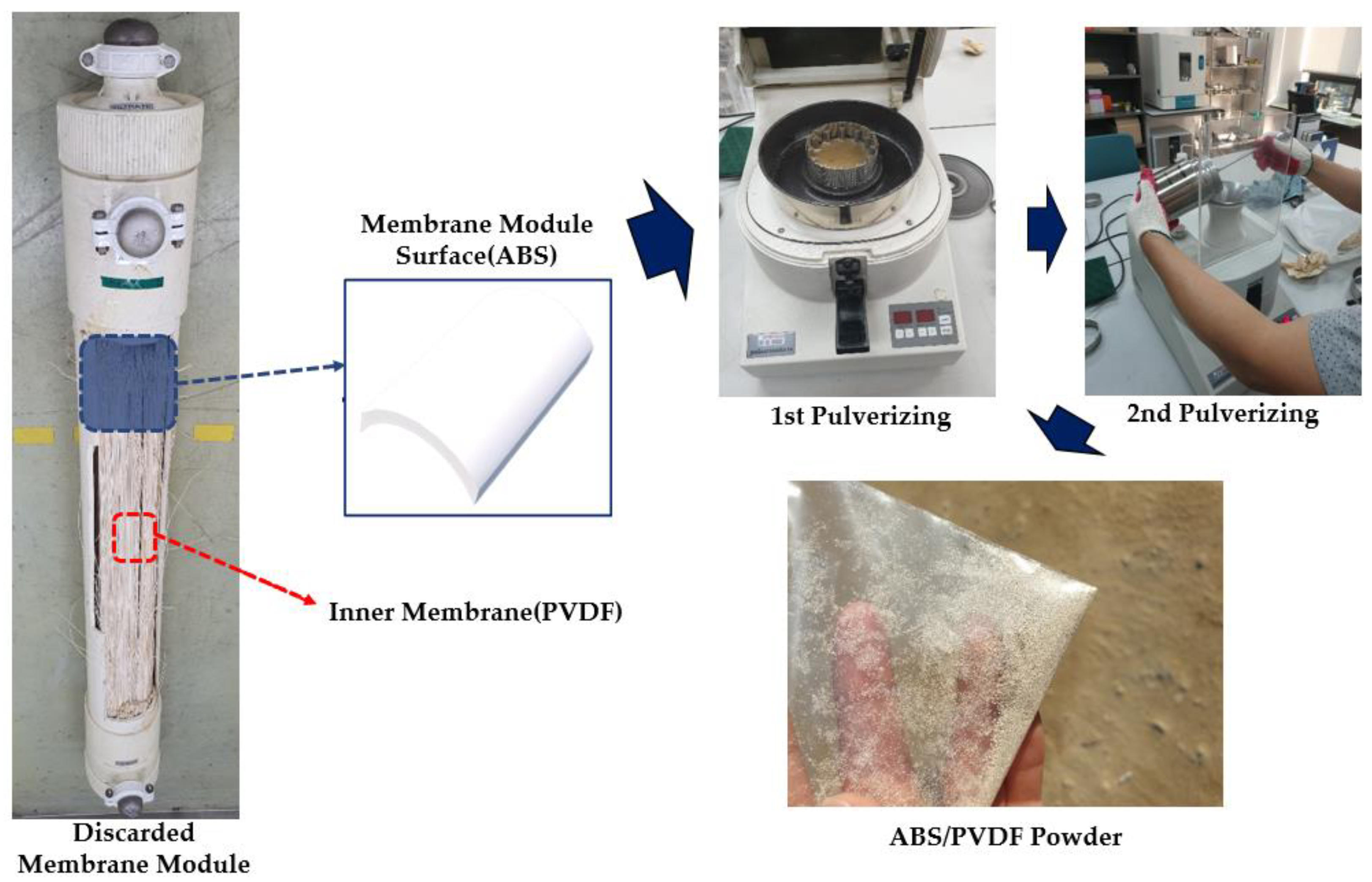


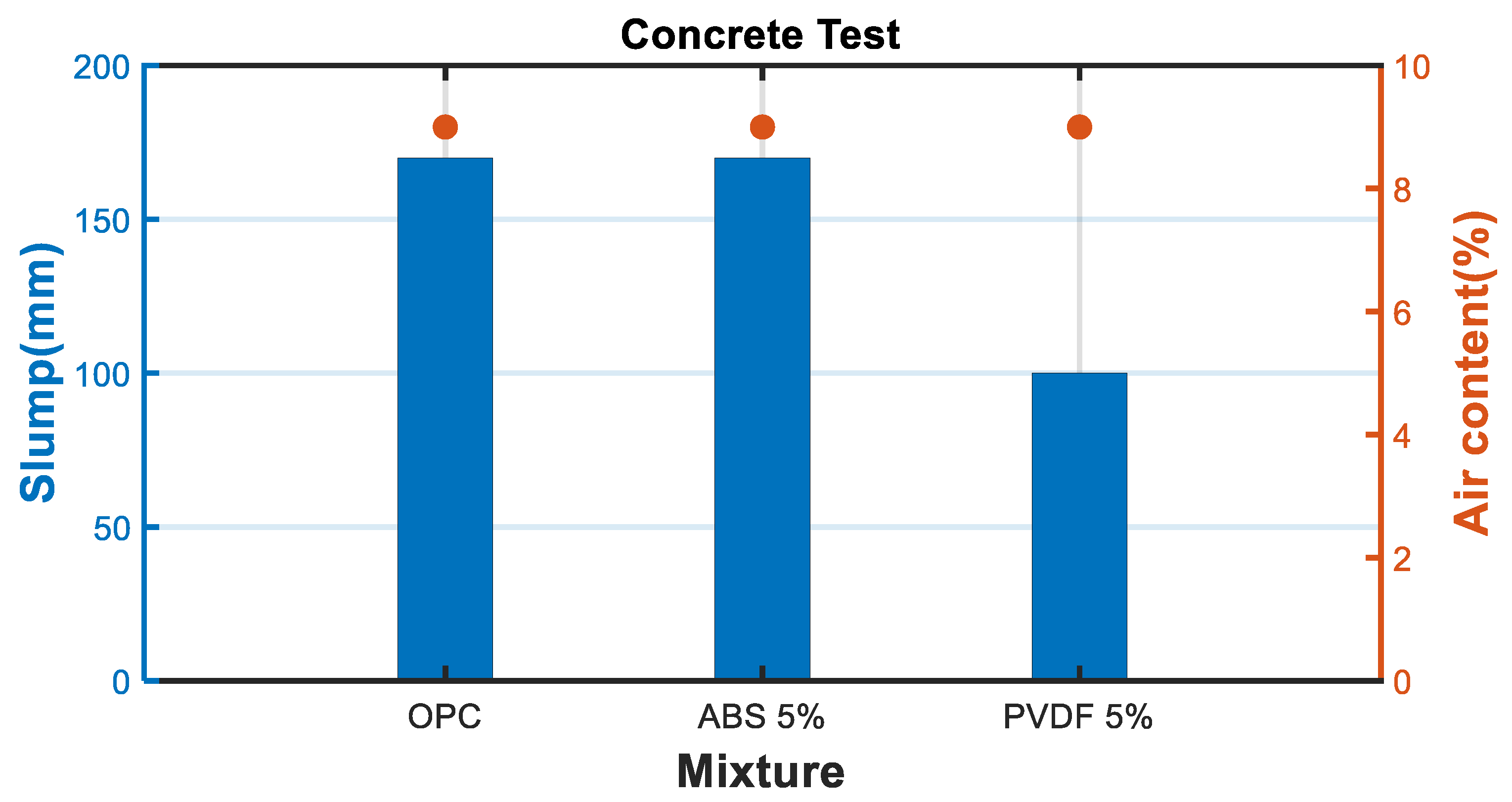
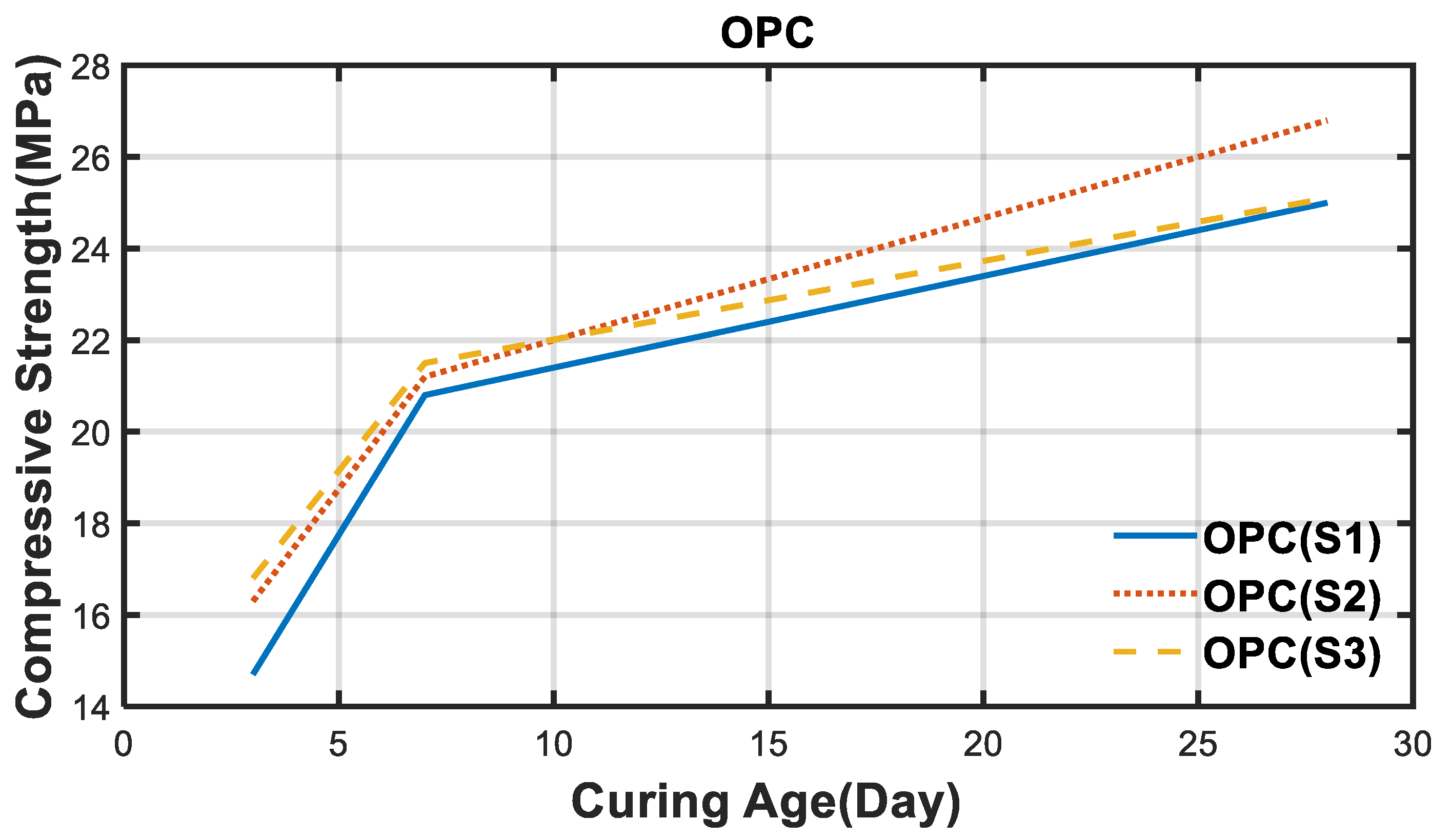
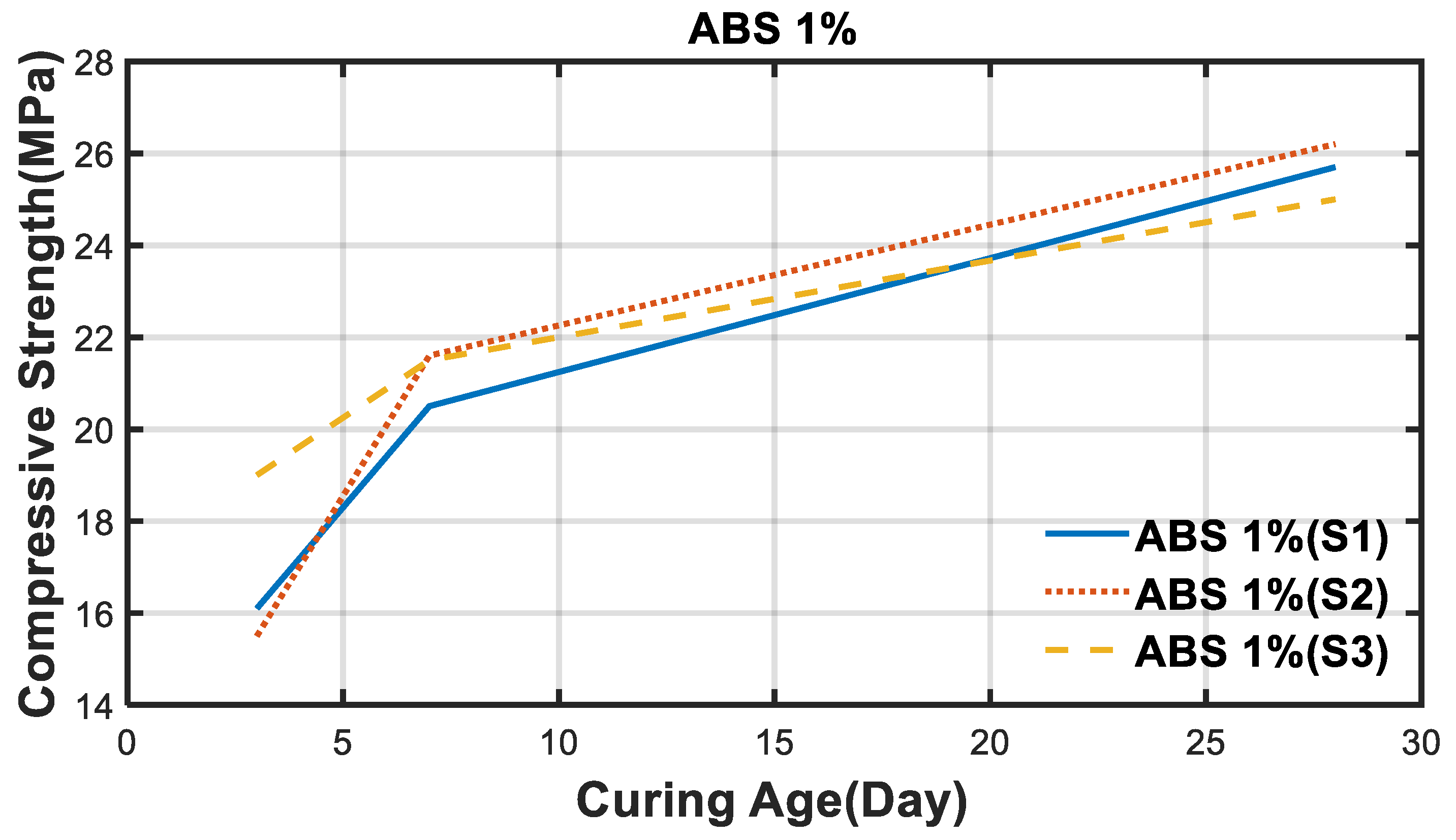

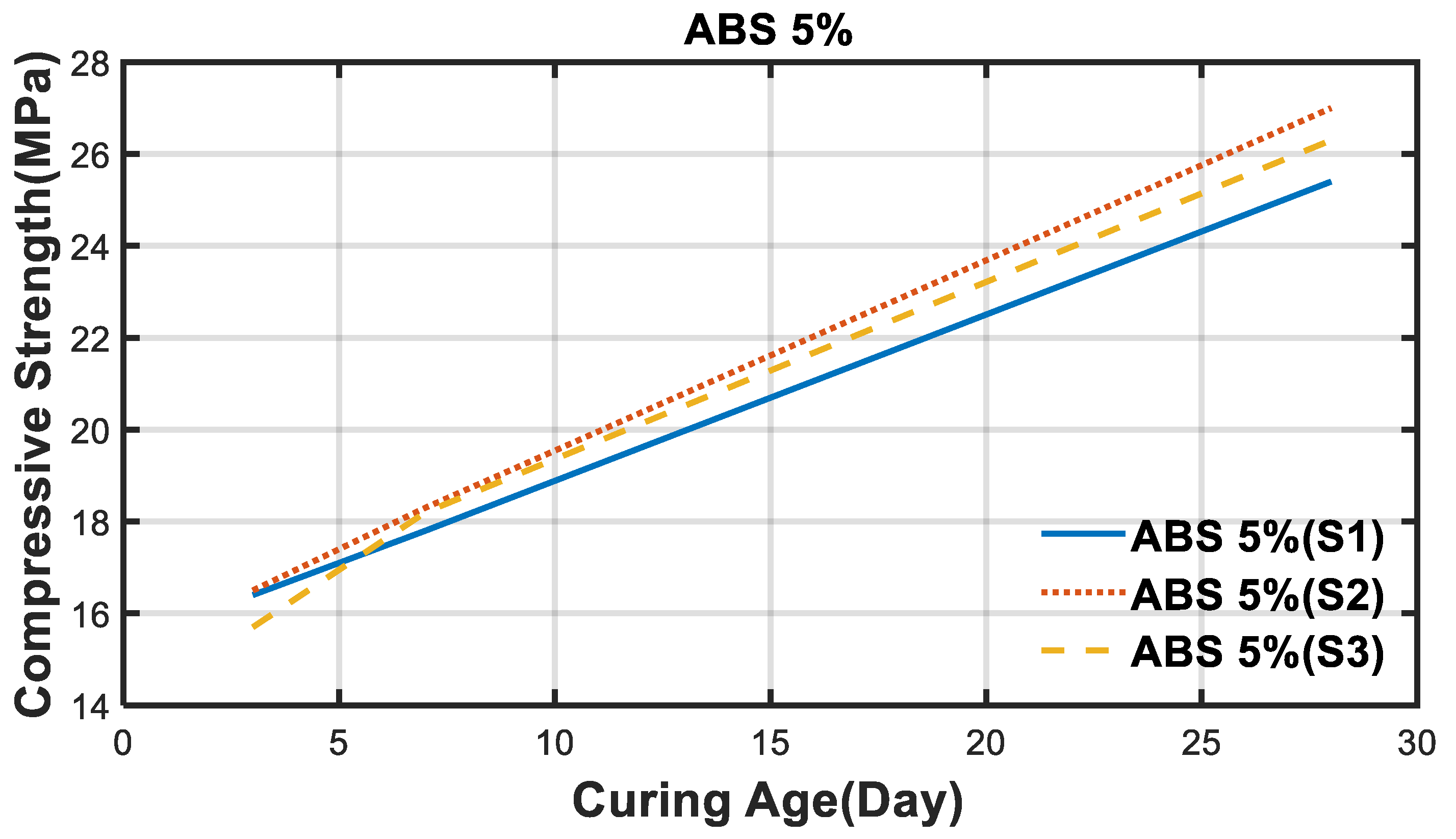
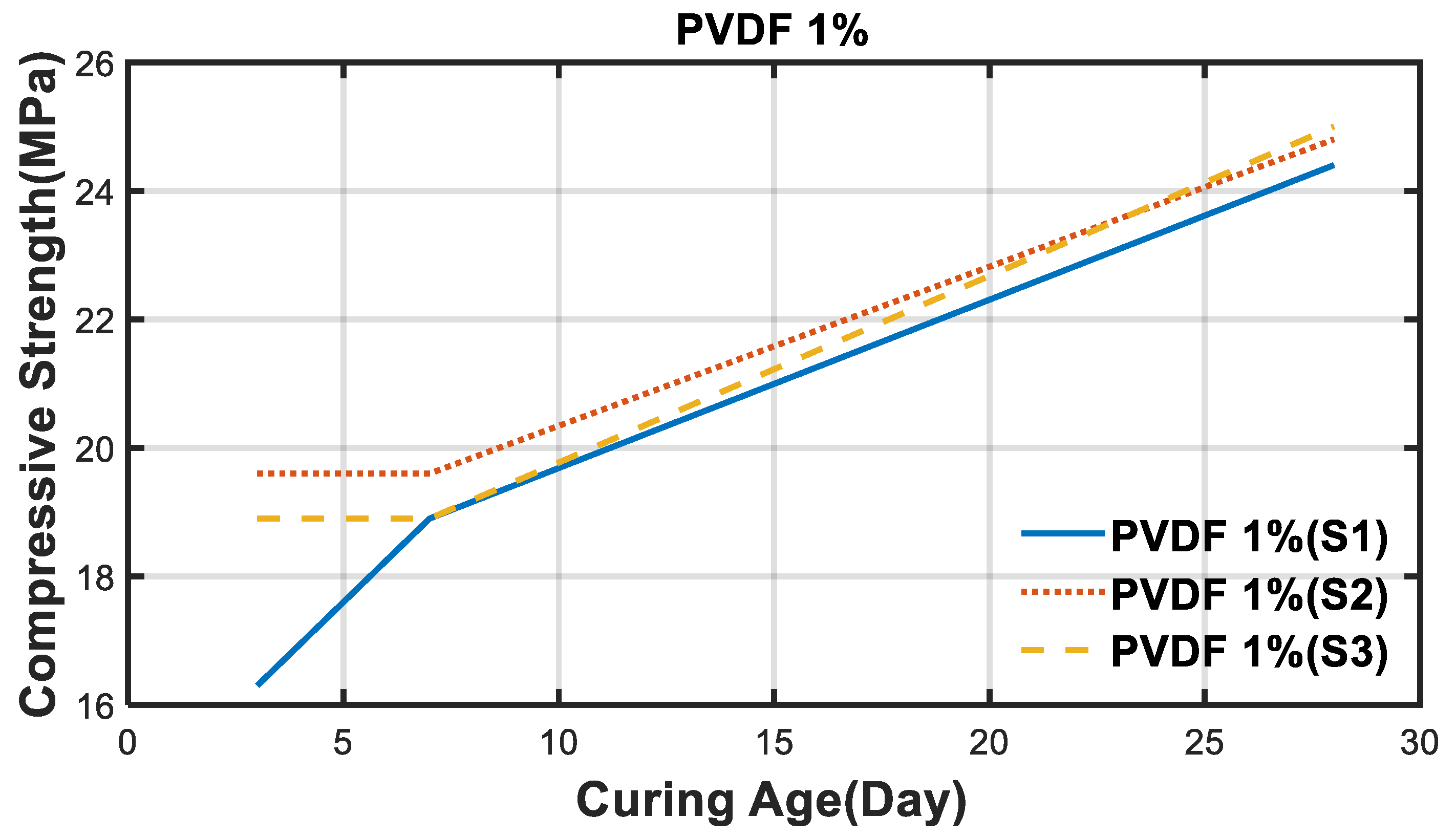
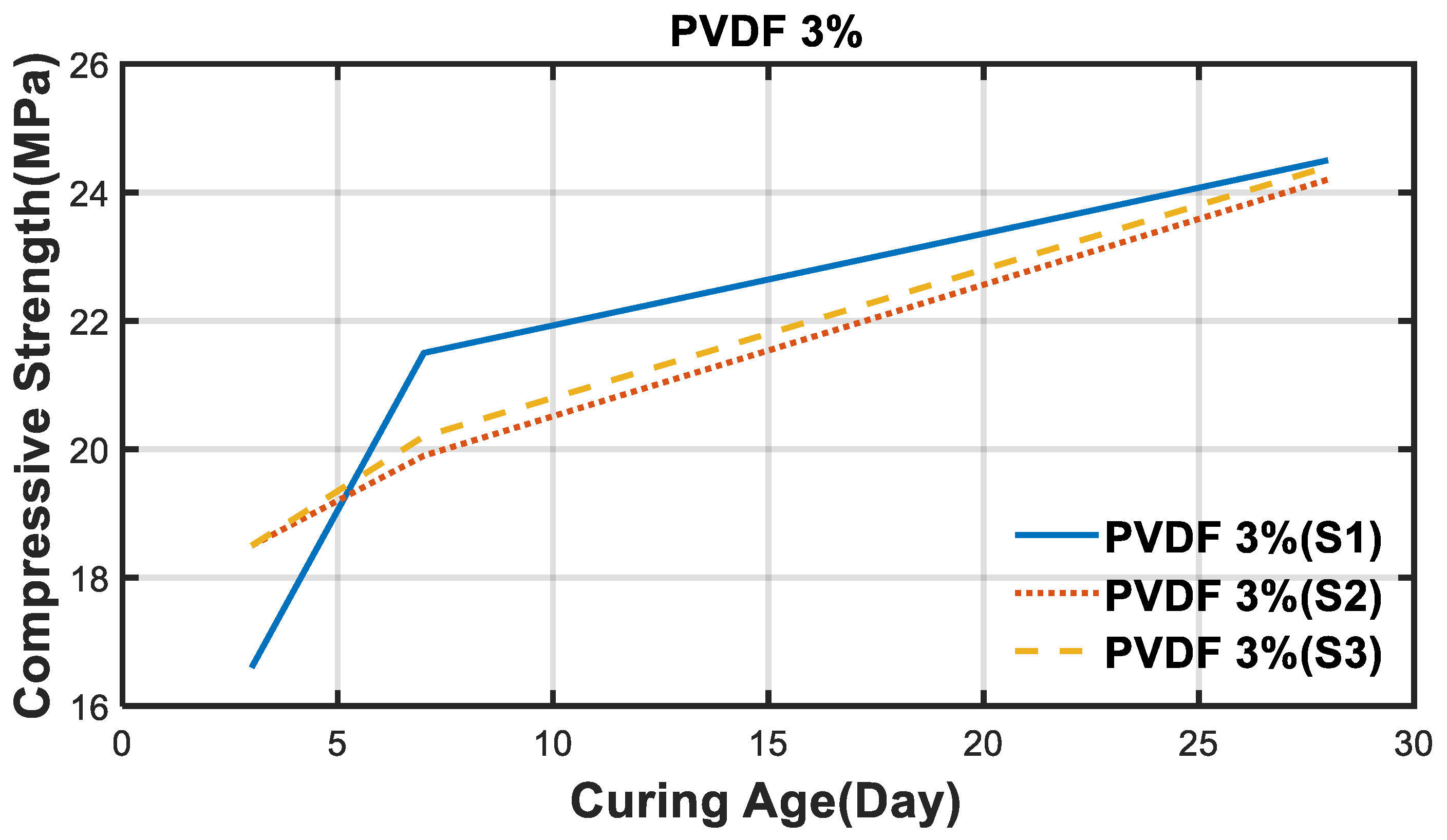
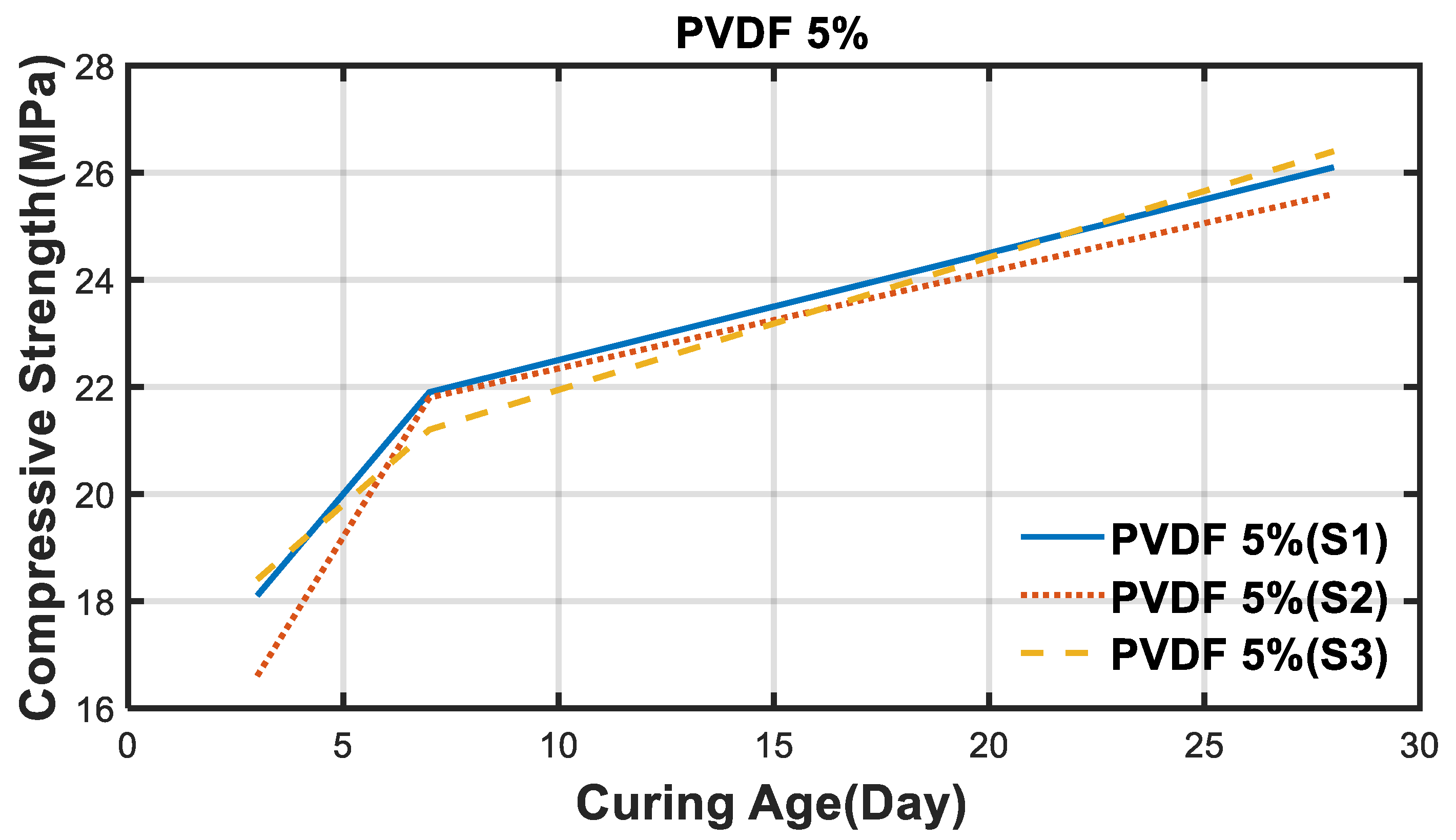
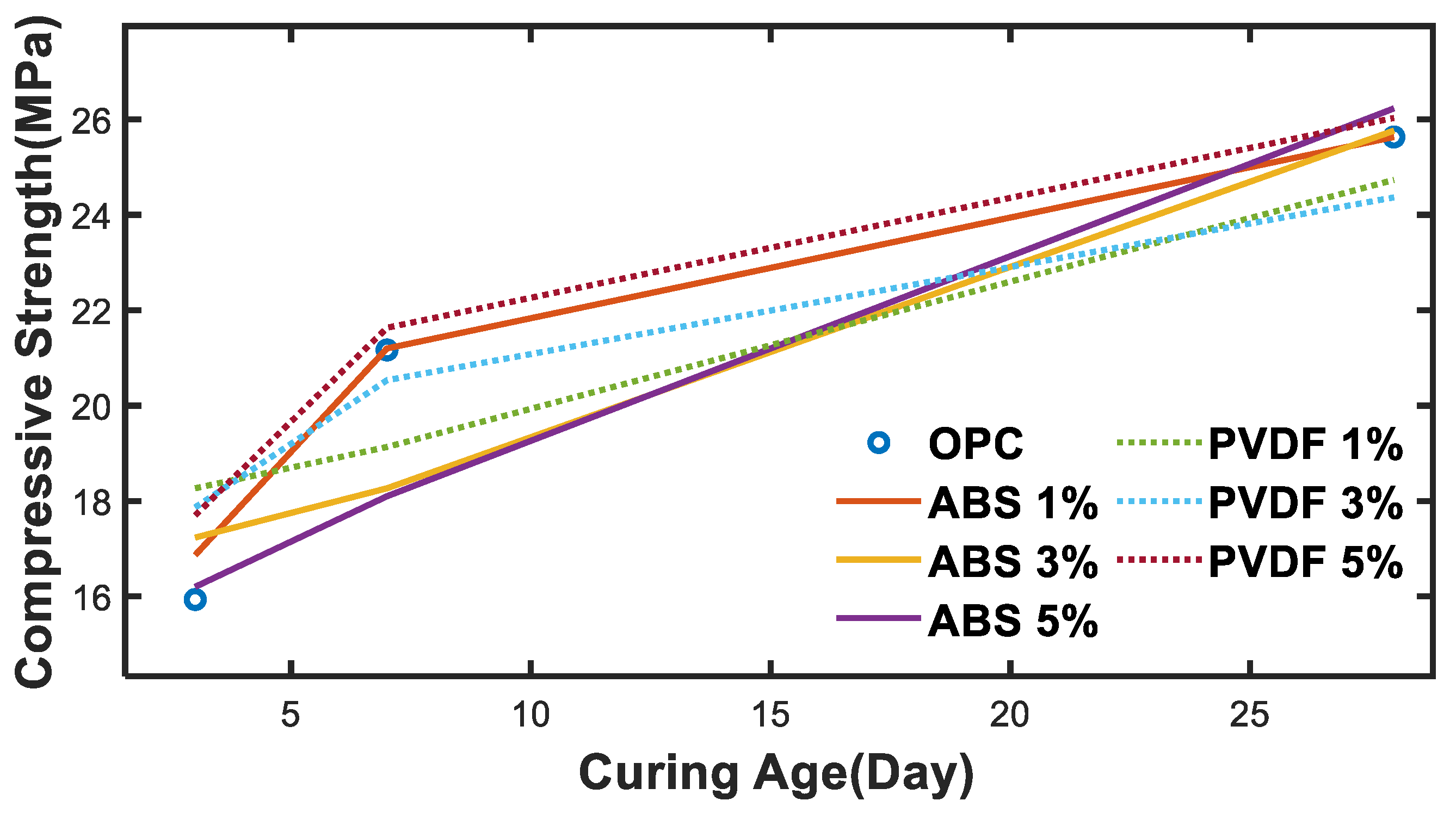
| Relative Density | Water Absorption Rate (%) | Tensile Strength (MPa) | Bending Strength (MPa) | Rockwell Hardness | Heat Distortion Temperature (°C) |
|---|---|---|---|---|---|
| 1.02–1.05 | 0.2–0.45 | 35–44 | 51–81 | R65–109 | 93–103 |
| Relative Density | Water Absorption Rate (%) | Tensile Strength (MPa) | Bending Strength (MPa) | Rockwell Hardness | Heat Distortion Temperature (°C) |
|---|---|---|---|---|---|
| 1.78 | 0.02 | 52–54 | 70–75 | R84 | 166–170 |
| C:S (Weight Ratio) | W/C (%) | Unit Amount (kgf/m3) | ||
|---|---|---|---|---|
| Water (W) | Cement (C) | Fine Aggregate (S) | ||
| 1:2.5 | 50 | 255 | 566 | 1430 |
| Waste Membrane Powder (%) | Modulus (GPa) | Strength (kgf/cm2) | Peak Strain |
|---|---|---|---|
| 0 | 6.15 ± 0.15 | 557 ± 38.9 | 9.74 ± 1.31 |
| 8 | 7.84 ± 0.17 | 464 ± 40.6 | 8.26 ± 0.65 |
| 15 | 7.43 ± 0.18 | 314 ± 54.7 | 6.33 ± 0.55 |
| 25 | 5.39 ± 0.33 | 107 ± 22.9 | 5.00 ± 0.20 |
| Specific Gravity | No.4 Sieve Remaining Amount | No.4 Sieve Passing Amount | Surface Water–Content Ratio | |
|---|---|---|---|---|
| Fine aggregate | 2.58 | 1.0% | 99.0% | 2.7% |
| Coarse aggregate | 2.65 | 99.0% | 1.0% | −0.3% |
| Unit (kg/m2) | ||||||
|---|---|---|---|---|---|---|
| W | C | S | P | G | AD | |
| Specified mix | 167 | 383(0%) 379(1%) 372(3%) 364(5%) | 789 | 4(1%) 11(3%) 19(5%) | 955 | 2.68 |
| Job mix | 149 | 383(0%) 379(1%) 372(3%) 364(5%) | 808 | 4(1%) 11(3%) 19(5%) | 954 | 2.68 |
| Mixture | Percentage (%) | Age (Days) | ||
|---|---|---|---|---|
| 3 | 7 | 28 | ||
| OPC | - | 15.9 MPa | 21.2 MPa | 25.6 MPa |
| ABS | 1 | 16.9 MPa | 21.2 MPa | 25.6 MPa |
| 3 | 17.2 MPa | 18.3 MPa | 25.8 MPa | |
| 5 | 16.2 MPa | 18.1 MPa | 26.2 MPa | |
| PVDF | 1 | 19.1 MPa | 19.2 MPa | 24.7 MPa |
| 3 | 17.9 MPa | 20.5 MPa | 24.4 MPa | |
| 5 | 17.7 MPa | 21.6 MPa | 26 MPa | |
Publisher’s Note: MDPI stays neutral with regard to jurisdictional claims in published maps and institutional affiliations. |
© 2022 by the authors. Licensee MDPI, Basel, Switzerland. This article is an open access article distributed under the terms and conditions of the Creative Commons Attribution (CC BY) license (https://creativecommons.org/licenses/by/4.0/).
Share and Cite
Park, S.; Kim, J. Performance Assessment of Concrete Using Discarded Membrane Filter Materials. Water 2022, 14, 2167. https://doi.org/10.3390/w14142167
Park S, Kim J. Performance Assessment of Concrete Using Discarded Membrane Filter Materials. Water. 2022; 14(14):2167. https://doi.org/10.3390/w14142167
Chicago/Turabian StylePark, Sehwan, and Junkyeong Kim. 2022. "Performance Assessment of Concrete Using Discarded Membrane Filter Materials" Water 14, no. 14: 2167. https://doi.org/10.3390/w14142167






